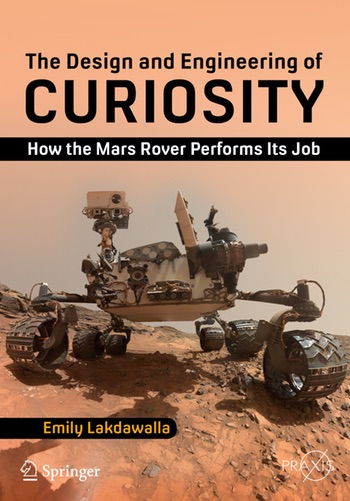Review: The Design and Engineering of Curiosityby Jeff Foust
|
| The Design and Engineering of Curiosity is by no means an entry-level book about Curiosity. |
Mars 2020 is able to draw up on not just the design of Curiosity but also the lessons learned in its development and operations. In The Design and Engineering of Curiosity, Emily Lakdawalla, senior editor and planetary evangelist at The Planetary Society, provides perhaps the most detailed technical study of that rover (at least outside of the project files at JPL) and its suite of instruments.
What would become Curiosity emerged from the revamp of NASA’s Mars exploration program after the twin failures of Mars Climate Orbiter and Mars Polar Lander in 1999. Those original plans called for a “mobile science laboratory” to be launched as soon as 2007, which morphed into the Mars Smart Lander concept of the early 2000s, which was then renamed Mars Science Laboratory. The mission because larger and more capable, but also more complex and expensive, with a soaring budget and delays that pushed the launch back to 2009 and then 2011.
The first chapter of the book recounts that history, while the second covers the spacecraft’s journey to Mars from launch on an Atlas V to landing using the innovative sky crane system. Lakdawalla shifts her attention to the day-to-day (or, rather, sol-to-sol) operations of Curiosity on the surface, including how the mission plans out the rover’s actions over the course of a sol, or Martian day. Later chapters focus on the technical details of the rover itself, and then its suite of instruments.
| The book was originally intended to be a single volume covering its first Martian year of operations, but the book grew so much that the rover’s science will be the subject of a second book. |
The Design and Engineering of Curiosity is by no means an entry-level book about Curiosity. While Lakdawalla offers a comprehensive study of the rover and its instruments, she goes into deep detail about all aspects of the rover, thanks to years of research about the mission. Unlike some other books (see, for example “Review: Curiosity”, The Space Review, August 4, 2014; and “Review: Mars Rover Curiosity”, The Space Review, October 20, 2014), this does not focus on the people of the mission but rather on the technical specifics of the spacecraft. And, in that respect, the book is thorough, including in the appendix a sol-by-sol summary of the rover’s activities from landing through last March.
One thing that the book doesn’t include is a discussion of the science performed by the mission to date. That is a deliberate decision: as she notes in the preface, the book was originally intended to be a single volume covering its first Martian year of operations. But as the mission went on and the information about it grew, she decided—with her publisher’s support—to split the book into two. The second volume, Curiosity and Its Science Mission: A Mars Rover Goes to Work, is scheduled for publication next year.
This book, meanwhile, is likely to be the most thorough engineering book to be written about Curiosity, a spacecraft that Lakdawalla describes in the preface as “the most complicated thing ever sent beyond our planet” and that “no one person on Earth understands all of its parts and functions.” She comes close, though, and after reading this book you will have a better appreciation of just how complex, and how capable, Curiosity is, even as JPL works on the Mars 2020 rover that may outdo it.
Note: we are temporarily moderating all comments subcommitted to deal with a surge in spam.
